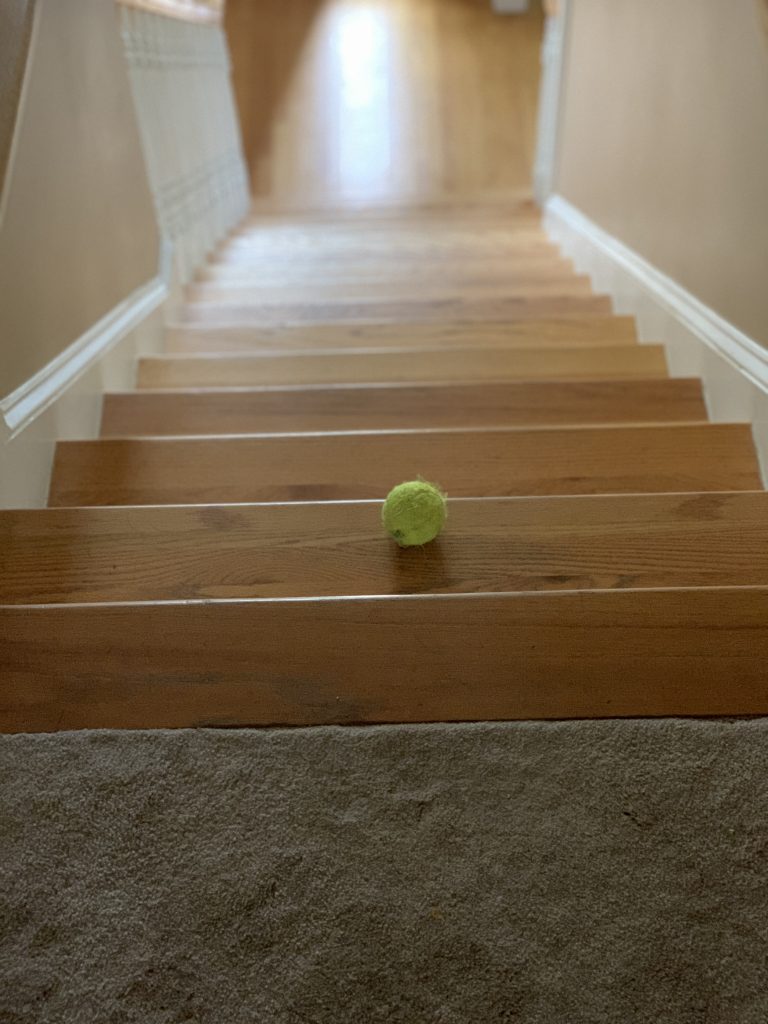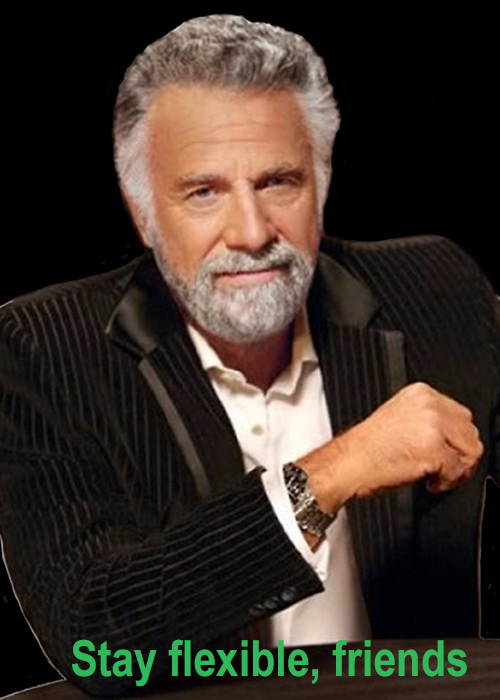As part of their morning routine, Lucille and Bixby have a super fun game that we like to call Staircase Catch. She stands at the top of the stairs and drops her ball, which plunks down each step like a slinky. Bixby catches it at the bottom and tosses it back up to her. She catches it in her mouth, then repeats the process again. For hours if we let her.
One morning the two of them played a bit, Bixby and I had coffee, then we all started our day as usual. Later that morning, I took a break from work to go downstairs and get a Diet Coke. This is the view.

Now, to Lucille, this looks like so much fun. To me, this looks like a trip to the emergency room. The same scene can be interpreted different ways. The decision to leave the ball on the stairs can have significantly different outcomes.
The same can be said about choices in our own lives. I agonize over decisions so that I can make the best choice because there could be so many different outcomes. I consider the pros and the cons, the return vs. the investment. “Analysis paralysis” is the pithy saying used to describe this. Ironically, often there is not a “best choice” when it comes to the decisions about our habits and routines. As long as we take any action at all – that is what matters.
Let’s take a look at three ways to get moving on habit change.
Start Small
It is hard to completely revamp habits all in one go. Start small. Instead of setting a goal to go to the gym every day, go once a week. Instead of writing 2,000 words every weekday, if you have more time on the weekend, do your 2,000 words on Saturdays and Sundays.
Sure it will take you longer to get to your end goal, but this is where we apply the idea of sustainability. We are not talking about fad diets and get rich quick schemes. I want to you to create sustainably productive habits. If you cannot stomach the idea of getting up at 5:00 am to go to yoga every morning – don’t do it!
But you do need to do something. Make it small.
Nope – smaller than that. It is hard, I understand. Sometimes it is hard to break it down smaller. How do I eat healthy smaller? If you would like to see a few examples, you can download what small sample changes I have been working on lately. I really do mean SMALL changes. But these are going to be sustainable changes for me.
Once you decide on what, set your cadence. How many times a week do you want to do it? Great, start with half that amount of days. SMALL CHANGES. You can adjust later.
Speaking of later – we need to pick a start date and an evaluation date. Not start and end dates – a start date and an evaluation date.
Set Deadline
Let’s say your goal is to paint 3 days a week after work. You have made the goal smaller and picked 2 days to paint once you get home. Well done, you. Now set an evaluation date for 30 days from now.
Go ahead – add it to your calendar, “Evaluate painting schedule.”
Then let fly your inner Picasso. For 30 days. No judgement, no changes. Paint for 2 days a week for 30 days – you have 8 opportunities!
After 30 days it is time to ask some questions. Keep this informal and short. Sit down for 5-10 minutes and ask yourself these simple questions
- Of the 8 times I planned to paint, how many did I complete?
- What worked about this plan?
- What did not work about this plan?
Don’t expect magic unicorns to shit rainbows. You may not have knocked it out of the park this month. Creating and changing habits – that’s hard work. You will probably need to make adjustments. Maybe during your evaluation, you identified that you only painted for 3 of the potential 8 days. Asking what worked and what didn’t will help modify your plan.
Do not automatically declare that your goal was wrong or you are a failure. Stay flexible, make modifications based on what you learned.

Stay Flexible
This is where folks will give up or water down their dream instead of staying flexible to meet the overall intention of what they were trying to do. Remember sustainable productivity is about finding what puts wind in your sails and doing it in a way that fits into your life today. In a way that you can repeat for the foreseeable future. You may need to make some changes in order to meet that sustainable productivity goal.
Here are some ways to do that:
Start
Once you have identified what tweaks to make in your process, decide what change you want to start. Just one – keep is small and sustainable. Maybe you planned to paint for 1 hour after work 2 days per week. After 30 days you have identified what is not working about this plan is that you spend 25 minutes of your precious 60 minutes setting up your supplies and work space.
What you may choose to start is to set up in the morning of painting day. Then all you have to do when you come home is paint – which is the whole goal.
Stop
Perhaps during your evaluation you found that by the time you came home, fed the dog, checked the mail, and changed clothes you lost your painting mojo. What you may choose to stop doing is checking the mail and changing clothes. Stopping those 2 things will streamline the process – feed the dog and paint. You can get an apron or old button down shirt to put over your clothes to protect them if needed. Maybe you change into painting clothes before you even leave the office!
Continue
This is often a hard one for people. We have to admit that maybe we are doing some things right. If you cannot identify one single thing you are doing right and need to continue, I will offer you a gimme. Continue the schedule. Until you hit the goal 100% for 3 cycles (90 days), continue your cadence. In this example that means painting 1 hour a day for 8 days will be the target for cycle 2. Set your next evaluation date for 30 days from now.
Don’t automatically declare that you are lazy and have no willpower because Netflix lured you to the couch on 5 of your 8 painting days. Maybe you sat down to check the mail and inertia just took over. It happens. You may need to alter your surroundings or order of operations to fit this new lifestyle you have. This Start – Stop – Continue exercise will help you identify and make those alterations.
Now, I hear what some of you are thinking: That’s all well and good if you know what you want to do! I get it. You might be feeling like you are living in black and white and an overall feeling of blah, but don’t know what is causing it. If this is you, I would like to invite you to use the Sustainability Checklist for a few days to help identify what is and is not working for you.
Let me know how these tools are working for you. Were you able to identify your start, stop and continue? What surprises did you find when you used the Sustainability Checklist for a few days?
Leave A Comment